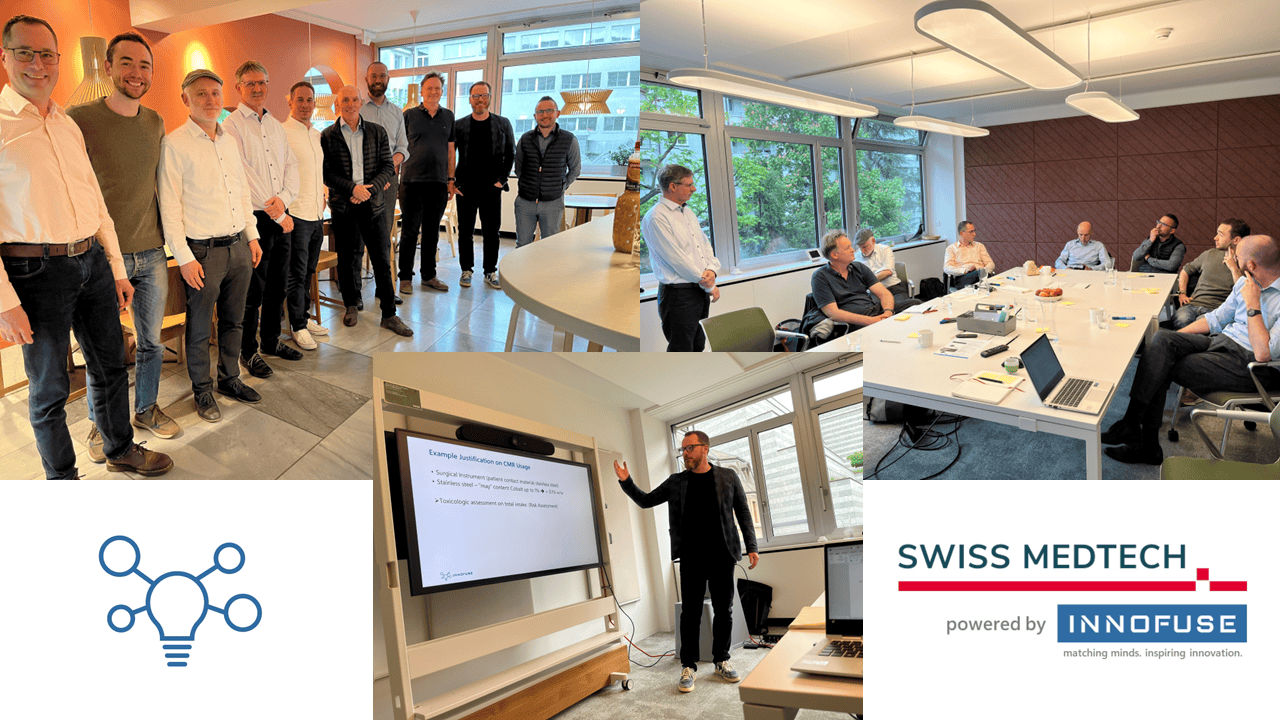First Honest Talk
PFAS in MEDTECH Industry
By Ivan Sanicola
April 28th . 6 min read

🚨 Honest Talk about PFAS in the Medical Devices Industry – How Is the Industry Responding?
First, the good news: you can find bellow our summary for free – because collective expertise should be shared, not siloed. Especially here in Switzerland, collaboration drives progress.
✅ Last week, we hosted the first-ever “Honest Talk” event co-hosted by Swiss Medtech, gathering experts across the industry to tackle one of our most pressing topics: PFAS regulations.
We asked: 🔍 What urgent steps must the MEDTECH industry take? ⚖️ How can we stay compliant and pragmatic? ❓ What’s still unclear – and when will we know more?
With new regulations from ECHA and EPA, the pressure is real. But the mindset was clear: solutions over fear. 💡
📝 Based on the discussion, Innofuse created a free one-pager with actionable insights. Want a copy? Drop us a message on info@innofuse.swiss, and we’ll send it your way.
📢 Bonus: A new Community of Practice (CoP) is launching on the Innofuse platform – open to all – for ongoing exchange, events, and learning around PFAS and regulatory challenges. Link to the CoP: Link
Let’s keep the momentum going.
Big thanks to Dr. Werner Schneider & Dr. Philippe Hasgall by Zimmer Biomet, Prof. Dr. Marco Rupprich by Hochschule für Life Sciences FHNW, Bernhard Pultar by POC APP AG, and to all our engaged participants from Camlog, Medartis, Alcon, Metecon Schweiz GmbH, and Swiss Medtech.
#PFAS #Medtech #HonestTalk #MedicalDevices #Innofuse #SwissMEDTECH #CommunityOfPractice #Regulations
Summary: Honest Talk by Innofuse - CMR-PFAS - 24th April 2025
1. CMR and PFAS in the Medical Device Industry – Key Takeaways
Lecture by Werner Schneider, Zimmer Biomet Use of PFAS
• PFAS are utilized due to their unique properties: chemical resistance, biocompatibility, inertness, flame resistance, and low specific weight.
• PFAS are ubiquitous. Any substance containing fluorine should be verified against regulatory lists (e.g., CAS, POP).
Health and Environmental Concerns
• Although PFAS are not inherently dangerous, their long-term accumulation is persistent, bio accumulative, toxic, and mobile.
• Experiments with zebrafish (Zebrafish experiments) have shown PFAS can have endocrine-disrupting effects.
Handling PFAS
• Upon identification of PFAS, objectives are to replace them, minimize usage (with annual reporting for derogated uses), and control emissions.
• Exception lists exist for substances without viable alternatives.
Regulatory Compliance and Challenges
• The medical device industry faces a complex web of environmental regulations, making compliance extremely difficult and at times seemingly "unmanageable."
• Relevant regulations include REACH, RoHS, CLP, EU MDR, POP, BPR, PFAS-specific regulations, CA Prop 65, and TSCA (U.S. REACH equivalent).
• Manufacturers must maintain Material Safety Data Sheets (MSDS).
• CAS numbers should be centrally stored and monitored to track newly regulated substances.
Life Cycle Assessment
• Effective life cycle management requires controlling the chemical supply chain, from raw materials through design, production, transportation, use, and end-of-life disposal.
• Relevant standards: ISO 14040 and ISO 14044.
Insurance and Supply Chain Risks
• Insurance companies are increasingly withdrawing coverage from companies handling PFAS, with some U.S. insurers cancelling policies immediately.
• Major suppliers like 3M plan to phase out all PFAS-containing products by the end of 2025 (3M will completely phase out PFAS), causing supply chain disruptions as key substances become unavailable.
• These disruptions could impact processes, batch production, and overall material availability.
2. Summary of Most Challenging Topics Regarding CMR/PFAS
Materials
• Identifying which materials, from patient-contact substances to auxiliary materials, contain CMR (Carcinogenic, Mutagenic, or toxic for Reproduction) substances.
Supplier and Supply Chain Management
• Managing suppliers who often lack awareness or understanding of CMR and PFAS substances.
EO Sterilization and Processes
• Understanding the role of CMR substances in Ethylene Oxide (EO) sterilization processes and exploring possible alternatives. Lack of Knowledge, Expertise, and Support:
• There is a strong need for accessible expertise and guidance to navigate the complexities surrounding CMR and PFAS management and regulation.
3. Summary of Brainstorming on Supplier and Supply Chain Management
Key Concerns
• Source Identification: Determining where PFAS enter the supply chain remains a critical issue.
• Process and Product Analysis: Identifying processes and materials (e.g., detergents) potentially impacted by PFAS restrictions. Analysing whether PFAS are present in final products to assess business risks.
Strategic Supplier Engagement
• Considering collective action through industry associations like Swiss Medtech or MedTech Europe, although current efforts are insufficient.
• Acknowledging that even large corporations struggle to manage PFAS risks; mid-sized firms can only mitigate risks through detailed analysis of their own products and production processes.
Industry Support and Regulatory Environment
• MedTech Europe has issued a high-level position paper (position paper), but no globally harmonized solutions exist, particularly for non-European suppliers.
• The MedTech industry proposes a 12-year phase-out period; however, some suppliers may exit the market much sooner, increasing risk.
Needed Actions
• Develop clear guidance on conducting thorough supply chain and production process analyses, including best practice examples.
• Establish a comprehensive strategy to manage PFAS risks, covering product and production chain analysis, risk mitigation, and regulatory tracking.